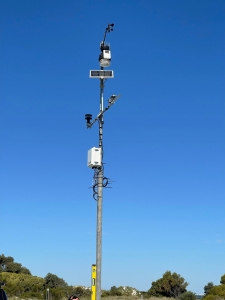An innovative new project is using human hair dye on Australian sea lions at Carnac and Seal Islands off the coast of Perth to track and learn about the local population.
Edith Cowan University (ECU) are jointly leading the project with Department of Biodiversity, Conservation and Attractions (DBCA) marine researchers, in collaboration with Department of Primary Industries and Regional Development (DPIRD).
The Australian sea lion (ASL) project forms part of the Western Australian Marine Science Institution (WAMSI) Westport Marine Science Program.
“The hair dye marks are temporary and completely safe, just like hair colour on a human, but for a period of about two months it allows us to identify each sea lion and monitor how often they move amongst the six haul-out islands, such as Carnac Island and Seal Island.
“This project also enables monitoring of the total numbers that occur in the Perth metropolitan area when the animals are at their peak numbers, which is anticipated to be around December or January,” ECU Associate Professor Chandra Salgado Kent said.
The marking method, which has been applied to other species of seals and sea lions elsewhere, is non-invasive and does not harm the animals in anyway.
It only takes a matter of minutes, less than an appointment to the hairdresser!
“A layer of dye is spread on numbers with foam material on them, and the numbers are mounted on a plate attached to a long pole, we then press the plate onto the sea lions back or side.
The poles allow us to keep our distance to create minimal disruption to the sea lions,” Associate Professor Salgado Kent explained.
Tracking via satellite
The use of satellite tags is also being deployed by the expert team, that includes DBCA, ECU and ANU researchers, DBCA and Werribee Open Range Zoo wildlife veterinarians and DBCA and DPIRD marine rangers and wildlife officers.
“We are trying to better understand how many sea lions use the area and where they may be foraging,” DBCA’s Kelly Waples explained.
“To do this we will be putting satellite tracking devices on a small number of sea lions. These tags are a small package that is unobtrusively glued to the fur on their back just behind their shoulders and will be retrieved from the sea lions in a couple of months’ time before the animals fully moult.”
The satellite tags have already been successfully attached to four sea lions, who were also marked with the hair dye.
Sea lion behaviour and conservation
Male sea lions tend to move between breeding islands around Jurien and haul-out sites in the Perth metro area, many using the Perth Metro Area during non-breeding periods.
The satellite trackers will help obtain high resolution information on where they forage and what habitat is important for them to find and capture their prey.
By understanding which habitats are important, the researchers can get a better understanding of how to manage and protect this endangered species, that have experienced a more than a 60% decline in numbers over the last 40 years.
Simple and effective
The satellite tags are attached only to the fur of the animal using glue.
“This ensures that the animal is not impacted by having the tag on them, and we retrieve the trackers after a month or two so that we can download the high-resolution data from the tag,” Associate Professor Chandra Salgado Kent said.
The ASL hair dye marking, and satellite tracking will continue over the next few months, providing the researchers with information on sea lion behaviours, movement patterns and numbers in the Perth metropolitan area.

